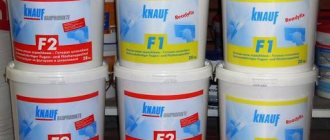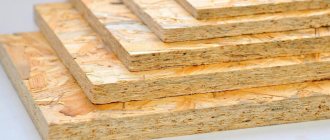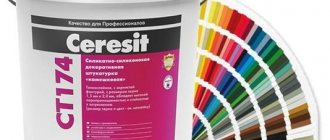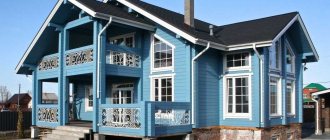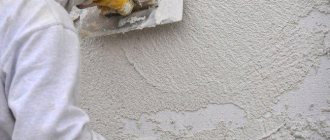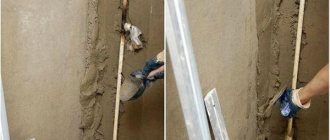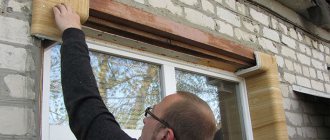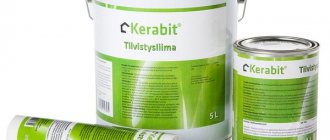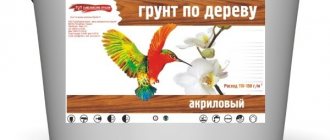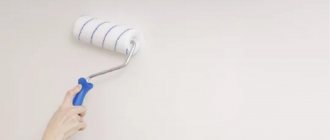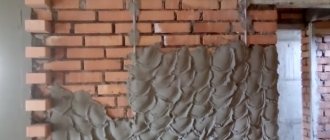Primer Basics
Primer compositions are based on different types of binders, which determines the scope of application:
- based on epoxy resins - for rooms with high intensity of action of aggressive liquids, with high mechanical loads;
- based on polyurethanes - for places with very high abrasive loads, conditions with constant vibration;
- based on methyl methacrylate - the best solution for unheated rooms and long-term operation in cold conditions;
- based on polyester compounds - for surfaces exposed to high chemical influences.
The basis of each primer is its main component, capable of high adhesion and dissolution of the corresponding active substances
Main types
Depending on the task you face when working with concrete, it is recommended to select different compositions. There are many varieties, so a few words need to be said about each:
A wall coated with primer does not absorb water
- Based on polystyrene. This primer is a solvent. It is aimed at removing dust and small debris from the surface, as well as minor polishing of small cracks and potholes, for the purpose of further application of paint. The use of this variety allows you to reduce paint consumption by 25 percent, improve overall aesthetics, and save your budget. The main thing is not to use such a primer for finishing walls inside, since its contents can have a toxic effect that affects the respiratory tract of residents.
- Based on polyvinyl acetate. Dries quickly, has a large area of use, suitable for walls and floors. After drying, it involves additional treatment of the walls with PVA glue, after which finishing can be continued.
- Based on epoxy resin. As in the previous version, the solvent is present in the mixture. This does not allow it to be used for residential premises, cellars for storing food, as well as greenhouses where flowers and plants will grow. On the other hand, such a primer is considered one of the best in terms of protecting concrete from destruction, especially from the outside.
- Alkyd primer. This option is only suitable for processing material externally. Removes dust and coats the concrete surface with a protective layer. A good primer, but with one drawback, it dries for at least a day.
- Acrylic based. This option positions itself as a primer for painting. This is the basis for concrete processing. It is colorless and odorless, since it does not contain chemically aggressive substances. It dries quickly and is inexpensive, which makes the soil accessible to the entire segment of buyers on the domestic market.
- Enamel based. Such processing tools appeared relatively recently, but quickly occupied their niche and are used in the treatment of walls from the inside and outside. External primer for concrete has its strong point - high adhesion.
- Deep penetration agents. Such compositions make the concrete stronger. For example, they are convenient if you have a concrete-based chimney and need to strengthen the outer walls to protect them from destruction. They penetrate up to 10 mm into concrete, are well absorbed, dry quickly, and are preparatory to further processing. One of the varieties of this option is soil containing quartz sand. It allows you to create a relief surface in concrete, which in the future increases adhesion to the base of porcelain stoneware or tiles, by applying a special glue to the concrete.
How to choose
The choice of working material is based on many design, technological and climatic parameters.
Type and strength of concrete base
When working with standard concrete bases, the grade strength of which is within M150-M300, polyurethane and epoxy primers are used. If the base is made of polymer-cement, magnesium floors, concrete with a strength of M350 or higher, it is recommended to use deep penetration primers. The same materials are best used for compacting and strengthening weak concrete floors (up to M150).
Application conditions
If work must be carried out at subzero temperatures, polyurethane primer is used. If it is necessary to apply the composition to a damp base, use a deep primer or deep penetration primer. If the smell is unacceptable during work, use epoxy primer.
Other parameters
In some conditions, it is necessary to take into account the level of vibration loads on the floor, chemical resistance parameters, and the time during which the object must be put into operation.
Classification of primer compositions by main component
The building materials market offers products based on acrylic, polyurethane, epoxy, polyvinyl acetate, and natural ingredients.
Polystyrene (polyurethane) primers
These compositions are highly toxic; for this reason, they are rarely used for interior surfaces for painting in residential premises. They contain solvents, so the solutions are only suitable for outdoor work (industrial buildings, facades).
Polyurethane-based products have the ability to fill pores and small cracks, remove dust from concrete surfaces and increase service life. Suitable for impregnating floors in industrial buildings.
Acrylic primers
Such primers have become more widespread; they are based on an acrylic component. They are characterized by the absence of a strong odor, combine well with any finishing materials, and are easily absorbed. It is allowed to start finishing work 3-4 hours after applying the coating.
The compositions are suitable for different types of premises, because they are non-toxic. Due to their ability to dry quickly, they are not suitable for outdoor use. They should not be used in rooms with high humidity.
Cannot be used on surfaces on which polyurethane dyes will be applied in the future (these materials are considered incompatible, the paints will peel off).
Water-based primers
These solutions do not pose a risk to human health; they are used in any room (including poorly ventilated rooms). Can be applied to surfaces that have not yet dried. The use of personal protective equipment is not required when working with such compounds. The cost of such primers is lower than others.
Organic primers
They are distinguished by their ability to penetrate deeply into the surface concrete layer; they are often used for impregnation and dust removal of low grade structures. Application at sub-zero air temperatures is allowed. Their service life is short because they evaporate quickly.
PVA and epoxy primers
Polyvinyl acetate compounds are suitable for quick finishing (half an hour is enough for them to dry). To improve adhesion, treatment with PVA glue is required.
To produce epoxy primers, resin is used. In most cases, the products are used when working with self-leveling floors. With their help, they increase the strength of the coating.
For interior work in residential premises, use is allowed provided that there are no pets or plants there, since the solvent has a pungent odor.
Epoxy primer for concrete
Primers of this type are made on the basis of epoxy resins. Ready-made compositions are characterized by unique characteristics, which are in demand on any concrete base.
Such materials are used for painting, for installing all types of epoxy floors (self-leveling, thin-layer, quartz-filled), and for pouring economical thin-layer transparent coatings.
Types of epoxy primers:
- one-component - the compositions are ready for use and only require mixing. The material is used on all types of surfaces, including those with poor absorption;
- two-component – most often used for the installation of self-leveling epoxy floors. The material requires preliminary preparation in accordance with the manufacturer's recommendation (two components are mixed proportionally: base and hardener). The first component, as a rule, is marked with the letter A - it is a transparent, colorless liquid. Second (B) – the hardener is a yellowish transparent liquid.
Technical specifications
Epoxy-based primers have high adhesion strength to concrete. The material provides good moisture protection and is fireproof. The finished layer demonstrates strength and resistance to wear during operation.
We can say that soils are characterized by deep penetrating ability, which contributes to the compaction and strengthening of concrete from the inside. The composition will prevent cracking and peeling of finishing paints.
The finished layer dries after 24 hours . The only limitation in application is that the material should not be spread over wet substrates. One of the significant advantages of epoxy floors is the absence of odor during application.
In low temperature conditions (closer to -20 degrees), a white precipitate may form in the base component. It does not stir or is difficult to stir.
To revive the composition, it is heated, preferably in a water bath. Warm-up temperature – up to +60 degrees. This operation will return all original properties.
Objects of application:
- warehouses, workshops;
- parking lots, garages, parking lots;
- supermarkets, exhibition and trading halls;
- freezers and refrigerators;
- agricultural objects.
Typical technical parameters of two-component epoxy primers are discussed in the table:
| Mass ratio of two components | 2:1 |
| Mass. share of non-volatile substances, % | 100 |
| Viability of the finished solution, min | 30 |
| Touch dry, h | 8 |
| Resistance to static action of water, h | 48 |
| Resistance to static action of xylene, h | 48 |
| Resistance to butyl acetate, h | 24 |
Polyurethane primer for concrete
Polyurethane primers are considered one of the best. They are more affordable compared to previous analogues.
Technical specifications
This type of soil is not inferior to epoxy in terms of adhesion parameters, and adhesion to concrete does not depend on its actual absorption. The material works successfully on dusty surfaces, binding dust and strengthening the base.
A significant advantage of polyurethane-based compounds is their resistance to high temperatures. This allows them to be used with functioning underfloor heating systems, for treating external concrete floors and walls.
Types of polyurethane primers
1.Basic. These single-component materials are used as often as possible. They help strengthen the base and increase chemical resistance. They work on M150-M350 concrete. Application is possible at sharply negative temperatures - down to -30 degrees . Polyurethane one-component primer is characterized by high fluidity and is capable of being absorbed into pores to a depth of 2-4 mm. Polymerization occurs due to air moisture.
2.Deep penetration . Such compositions are able to effectively absorb into the pores of concrete, penetrating to a depth of 4-6 mm or more. This solution is suitable for concrete grades M350 and stronger. Maximum hardening is achieved at M100-M300. Can work on wet surfaces .
After applying the deep penetration primer, a two-week exposure is required, after which you can begin painting
3.Deep primer . This is a two-component composition with improved penetrating ability. In addition, it is characterized by astringency, which is effective when processing magnesium, polymer-cement concrete and other bases with low porosity.
On weak concrete, the primer works as a strong hardener . After polymerization, a chemically resistant layer with high mechanical strength is formed. Deep soil is very fluid, works at the highest possible binding capacity and penetrates deep into concrete, including low-porosity, wet substrates. But, the consumption of such materials is 30-40% higher than that of simple polyurethane primers. To saturate concrete with M350 you will need about half a kilogram per 1 sq.m.
Deep soil is capable of exhibiting the texture of artificial stone and is suitable for application both indoors and outdoors. It is used as a sealing, strengthening, dust-removing agent on surfaces subject to high-intensity loads . The finished layer is resistant to shock loads and abrasion. After impregnation, the base takes on the appearance of varnished concrete.
The finished layer demonstrates constant resistance to the following negative factors:
- water;
- aqueous solutions of acids of 5-10% concentration, salts, alkalis of any concentration;
- synthetic, mineral, organic fats, oils;
- diesel fuel;
- petrol.
Scope of application: low-porosity, dense, magnesium concrete, concrete tiles, high-strength concrete M350 and higher, moist but not wet bases, including those with poor quality waterproofing (there is capillary suction of water).
Typical technical parameters:
| Mass. fraction of non-volatile substances | 40% |
| Viability | 1 hour |
| Duration of layer-by-layer drying | 24 hours |
| Pedestrian load | A day later |
| Full mechanical load | After 3 days |
| Tensile strength | 27 MPa (after 14 days) |
| Elongation at break | 70% |
Why is concrete priming necessary?
A deep penetration primer for concrete is an ideal option to really prepare the surface for further processing and improve its properties and characteristics.
Some people believe that a concrete base does not need additional protection, but in fact this is not the case. Of course, this material has a fairly high strength index and a long service life, but it can also suffer under the influence of an aggressive environment or other unfavorable factors.
Moisture gets into the material through the pores, which can cause delamination in the future or the appearance of serious cracks. Concrete, as a rule, contains reinforcement, which can begin to rust under the influence of various factors and gradually collapse. Particular attention should be paid to concrete floors, the top layer of which is quite loose and may begin to deteriorate during use. This not only negatively affects the appearance of the floor covering, but also on human health, because a large amount of dust begins to be released. A deep penetration primer for concrete can eliminate all these problems and reliably protect the material for many years.
How it works
Priming concrete offers a huge number of benefits, so this process should not be ignored.
- The mixture will bind dust particles together and the surface will become cleaner.
- In the future, the base will be reliably protected from moisture, mold and mildew.
- Special deep penetration compounds can improve the adhesion of the base to the top coat several times. Due to this, cracks and other defects will not appear in the future.
- Finishing materials will be much better applied to the surface, and their consumption will be noticeably reduced, which will save on repair work.
- A deep penetration primer can close even the deepest pores of concrete, which will increase its service life and protect it from harmful factors.
- The top layer of concrete will become more durable and will withstand heavy loads and not be afraid of mechanical damage.
Deep penetration primer for concrete is a great way to make better repairs that will last a long time.
Scope of application of primer for concrete
Deep penetration compositions can make the concrete structure less porous, which makes the material more resistant to various external factors.
In addition, the adhesion rate increases. Concrete has a fairly high density and does not absorb compounds well. Therefore, painting or applying a layer of plaster without priming will not bring the desired result.
Also, an excellent option would be to use a deep penetration mixture if fairly heavy wallpaper will be used in the future. Otherwise, they will begin to fall off over time, because no adhesive can withstand the heavy weight on a concrete base. Although concrete primer can be used to treat this material, experts also use the mixture for other purposes. With its help, plastered walls, bricks, foam concrete blocks and gas blocks are made more durable. Due to their excellent properties, such compositions are considered universal.
Such products can be used to prepare rooms where there is a high level of humidity, because they protect against the appearance of fungus and mold. Deep penetration primers contain special components that have an antiseptic effect, so they will not allow harmful bacteria to multiply.
Acrylate, acrylic primers for painting
Materials of this group are used for processing concrete facades, as well as for indoor work with subsequent coating of walls with water-dispersion paints.
As a rule, the material is used under acrylic facade paints
Acrylate primer improves adhesion, evens out the absorbency of the base, and provides a water-repellent effect . The finished layer helps reduce paint and varnish materials when applying finishing coatings.
The peculiarity of acrylic materials is that they are well suited for processing previously filled and plastered surfaces. The advantages of this solution are increased weather resistance, a significant increase in strength and adhesion to the base. Acrylic primer significantly reduces the consumption of finishing layers .
Typical technical characteristics of acrylic primers:
- wt. the share of non-volatile substances is 30-40%;
- viscosity – 20-40 sec.;
- drying time of the layer – 10 hours;
- resistance to static action of water – 24 hours.
Classification of primers according to the quality of the base
When classifying according to the characteristics of the base, porosity and the level of friability are taken into account.
There are the following groups of compounds:
- deep penetration;
- adhesive;
- impregnating.
Deep penetration primers
This type is intended for concrete surfaces with high porosity (especially when there are many deep pores). The solutions penetrate 5-7 mm deep and have good adhesive capabilities (when the pores are deep, this is especially important, since the voids are clogged with the formation of a durable film).
To achieve good adhesion, the compositions contain:
- latex particles;
- acrylic;
- quartz sand;
- antiseptic substances;
- polymer additives;
- plasticizers.
Such mixtures are well suited as a base for plaster:
- lime-cement;
- plaster;
- lime-gypsum.
These impregnations are recommended for walls, as well as screeds during restoration work. Before the advent of this type of primer, they were not repaired. The primer should be applied in several layers, since increasing the thickness of the impregnation increases the strength of the structure.
Adhesive primers
These products create an invisible film, giving it roughness (since the composition contains inclusions of quartz sand). This allows you to increase the adhesion qualities.
The primer is used for external and internal work.
Such products are well suited for treating coatings made from the following mixtures:
- polymer;
- gypsum;
- cement-sand.
They are suitable for wall treatment using:
- gypsum fiber and plasterboard boards;
- ceramic tiles;
- tree.
To treat surfaces that have already been coated with paint or putty, you should use adhesive compounds.
Latex primers for concrete for painting
Essentially, these are concentrates of synthetic polymers. Materials of this type are distinguished by the fact that they create a moisture-proof, water-repellent coating on the surface of concrete. They are used indoors and outdoors, including on highly absorbent substrates.
Latex reinforcements work effectively both on walls and on floors, including under heated floor systems. It is necessary to take into account that the composition is characterized by an antiseptic effect , prevents the development of mold, fungi, bacteria, which is important against the background of high humidity.
Latex primers are used in diluted or concentrated form. They are characterized by a milky white color and medium fluidity.
Proportions are chosen based on the goals of the work:
- soil/water 1:5. Treatment of porous concrete for painting, which reduces the absorbency of the surface and significantly increases adhesion;
- soil/water 1:2. Treatment of complex surfaces (dusty, highly absorbent);
- concentrated latex primer. It is used for additional strengthening of low-strength concrete, priming of heavily dusty bases.
Typical technical parameters:
- dry residue – 16%;
- density – 1000 kg/cub.m.;
- viscosity – 5 s;
- Drying period – 60 minutes.
Latex primers double the adhesion properties of concrete
Properties and purposes of the primer
The main purpose of the primer is to increase the adhesiveness between the working surface and decorative coatings and finishing materials. By forming a thin film on the surface, the moisture resistance of the base increases. Other properties include:
- increasing the strength of the wall/ceiling;
- binding of loose structure;
- preventing the development of mold/mildew.
Compositions for surfaces made of different materials are available. Products are classified by area of application: for indoor and outdoor use. Thanks to various additives, the properties of impregnations are enhanced.
Fungicides prevent the formation of microbiological processes, anti-corrosion substances extend the service life of metal structures, silicone agents increase moisture resistance, which gives the base waterproofing characteristics. The presence of latex in the composition indicates the high adhesive qualities of the material.
Primer: types, mistakes, how to deceive? | Secrets of materials and advice from a professional
Anti-corrosion primers are suitable for processing not only metals, but also reinforced concrete products.
Alkyd primers
Such primer compositions can be called universal.
The industry offers several varieties:
- alkyd glyphthalic primers - used indoors and outdoors for treating any concrete surfaces. Universal enamels and paints fit perfectly on top of the layer;
- perchlorovinyl - in demand exclusively outdoors. The layer dries within 60 minutes;
- polyvinyl acetate - works in tandem with alkyd paints. This soil dries out within half an hour;
- polystyrene - due to high toxicity, it is used only outdoors;
- Alkyd-urethane primer enamel is a solution for coating metal structures.
Types of deep penetration primer for concrete
There are several types of soil for concrete, which differ in their composition:
- Polyvinyl acetate. This primer is used for painting or wallpapering. It has quick-drying properties, complete drying time is thirty minutes. After priming, the walls are treated with PVA glue and the base can then be painted or wallpapered.
- Polystyrene. The solution contains toxic substances such as solvent. Therefore, such primer for concrete is intended for outdoor work. This mixture creates a strong adhesive film on the base, which increases adhesion between the coating and specific types of paints.
- Epoxy primer for concrete. It is ideal for self-leveling floors because it can significantly increase the material’s resistance to wear and deformation. The solution can only be used in non-residential premises, since it contains a very caustic solvent.
- Alkyd. This primer is intended for interior concrete work. Although it dries for a long time, it creates a special protective film on the base, which provides adhesive properties to the material.
- Acrylic primer for concrete. This option is the most popular because it does not contain toxins and is odorless. It dries perfectly and absorbs well. This primer is perfect for processing aerated concrete blocks, as it creates a smooth and seamless coating.
- Enamel. The mixture includes a special primer and paint. It creates a special protective film on the base, which increases the adhesion of the coating to any finishing materials.
- Deep penetration soil. This primer is suitable for aerated concrete, and it is also applicable for any brand of concrete base. Such a solution is capable of penetrating into the base up to 9 millimeters, which significantly increases the adhesion of the soil to the finish. This ability is explained by the content of latex particles in the mixture, which firmly grasp the base.
- Polyurethane primer. PU primer for concrete is intended for self-leveling floors. It has excellent impregnating properties and is suitable for processing under any finishing materials.
Application technology
Priming concrete for painting is one of the main technological operations. Any mistakes can affect the quality of the finishing coating, including complete replacement. These are serious and unjustified financial losses.
Concrete preparation
The principles of preliminary preparation are always the same. All surfaces to be treated must be cleaned. The floors are sanded using a mosaic sander. It is permissible to use shot blasting or sandblasting, which is also important on vertical structures. Chemical cleaning may be used for walls.
During the work, it is important to completely open the pores of the concrete and remove the laitance (on new concrete) . The weak surface layer, dirt, old coatings, and oily areas are completely removed from old concrete. Immediately before applying any type of primer, the surfaces are dusted with industrial vacuum cleaners.
Features of applying one-component polyurethane primers
In order for the material to work effectively, waterproofing is installed on the lower floors. This will eliminate backwater and capillary suction of water from below to the floors. If they are working on freshly laid structures, a 28-day curing period is required , given that the concrete matures under normal conditions.
Working conditions:
- t surface and air - -30+25 degrees;
- primer t - +10+25 degrees;
- t base 3 degrees above the dew point;
- air humidity – no higher than 80%;
- base humidity – 4%.
It is unacceptable to have oily areas that are not removed during preliminary preparation.
Application:
- One-component polyurethane primer is ready for use. Materials from some manufacturers do not even require mixing;
- working methods: rollers, brushes (solvent-resistant), airless sprayers;
- The primer for painting is applied until the coating is uniform and the appearance of wet concrete appears. The pores of the artificial stone must be completely closed;
- practice shows that 1-2 passes are enough. In the latter case, the layer-by-layer drying time is observed, which takes 3-8 hours.
The average consumption of one-component polyurethane primers is 150-300 g/sq.m.
Features of the use of two-component polyurethane primers of deep penetration
Application conditions:
- subject to normal hardening, the age of the concrete should be 14 days;
- t base, air, material - +5+25 degrees;
- waterproofing is required; capillary rise of water from below is unacceptable;
- concrete moisture content – 6% by weight;
- t base – 3 degrees above the dew point.
Application:
- deep penetration polyurethane primers are two-component compositions. Both components are mixed by volume 1:1;
- The base composition and hardener are mixed using a construction mixer for 2-3 minutes. Rotation speed – 400-600 rpm;
- the finished material is applied mainly using polyamide rollers with medium pile (12-16 mm). In practice, 2-3 approaches are required. Each layer should dry for 6-8 hours;
- the average consumption varies between 150-400 g/sq.m., which depends on the absorbency of the concrete. The material is applied until a uniform shine of wet varnished concrete appears over the entire surface.
Features of the use of deep primers
Application conditions:
- t of application - +5+25 degrees;
- base humidity – 6%;
- absence of contaminated, oily areas.
Application: the two-component composition is thoroughly mixed with a construction mixer. For high-quality kneading, 2-3 minutes and a speed of 300-400 rpm are enough. You should remember the viability of the mixture - 60 minutes . It is recommended to apply the finished composition with a polyamide roller or brushes in 2-4 technological approaches. Drying each layer takes 6-8 hours. Before painting, primer is applied until a uniform wet surface is obtained.
Features of applying acrylate primers
Application conditions:
- t of application +5 degrees and above;
- air humidity – no higher than 80%;
- When working outside the premises, strong wind, precipitation, and direct sunlight are unacceptable.
Acrylate primers require thorough mixing
Application can be carried out using rollers, brushes, and paint sprayers. It is enough to apply 1-2 layers, which depends on the actual condition of the surface . If a paint sprayer is used, the composition should be applied evenly and generously.
The average consumption is 1 kg/10-12.5 sq.m. Layer-by-layer drying time takes 1-2 hours under favorable application conditions. If the air humidity exceeds 65% and the temperature is below +15 degrees, the next layer is coated only after 12 hours of drying the previous one.
Features of the use of acrylic primers
Application conditions:
- t air – not lower than -15 degrees;
- dry, non-icy base.
Application: acrylic primers are applied with sprayers, brushes and rollers in 1-2 technological approaches. Layer-by-layer drying takes 10 hours, provided that the air temperature is above +20 degrees. The consumption of the composition depends on the roughness and absorbency of the surface. On average, it will take 0.2-0.3 kg to cover one square meter.
Features of using latex primers for painting
Application conditions: t surface, environment - +5+50 degrees . Before use, the soil is thoroughly mixed. The composition is brought to the required concentration.
The work is carried out using airless and air spray guns or using a brush or roller. It is recommended to apply the composition in 2 approaches, which will eliminate incomplete treatment of the base.
Drying time for each layer is 30 minutes . The finished surface must dry for at least an hour. Consumption depends on dilution proportions.
The concentrated solution is consumed in an amount of 50 g/sq.m., in a ratio of 1:2 - 16 g/sq.m., in a ratio of 1:5 - 8 g/sq.m.
Features of the use of alkyd primers
The primer is used in its pure form or requires dilution with organic solvents, such as white spirit. For application, brushes and rollers are used, applying the composition in 1-2 technological approaches. It must be remembered that the material is particularly toxic and requires compliance with fire safety standards.
How to paint concrete after priming
Paints intended for use on concrete differ in their protective, operational characteristics, and application features.
Epoxy paints
It is recommended to use epoxy primers for such materials. The paint itself is a two-component composition that requires mixing immediately before application. This is a good solution for interior work, especially for painting floors. This is due to its high chemical resistance, wear resistance, and water resistance.
Acrylic
Application is carried out over acrylic and acrylate primers. The material works well indoors, providing resistance to high humidity and temperature changes. This is facilitated by high decorative characteristics, a variety of textures and colors.
Acrylic paints are often used to treat ceilings and walls
Polyurethane paints
The composition provides high resistance to chemical attack and other operational loads. In practice, application is carried out on concrete coated with polyurethane primers (one- or two-component). The main purpose is to cover floors. Like acrylic compositions, a nice appearance is ensured.
Rubber
This wear-resistant paint is renowned for its resilience. A film based on such material can be bent and rolled without breaking its integrity. These properties work well under mechanical loads, which is why the material is used to cover indoor floors. It is better to apply rubber paint over an acrylic primer.
Urethane-alkyd
The material demonstrates high hiding power and high abrasion resistance. The finished surface is glossy, but you can expect a wide variety of colors. The paint adheres well to alkyd primers.
Composition of primer for concrete floor
We figured out what primers there are based on their properties. Such different effects are achieved because they are made on the basis of different substances. This is reflected in the properties of the final product and affects the scope of application. The following primers can be used for concrete:
- acrylic;
- silicone (organosilicon);
- epoxy;
- polyvinyl acetate;
- silicate.
This is just the basics. Adhesives, abrasive particles, antifungal components, and other additives are added to the “base” solution. The specific composition varies depending on the manufacturer and on what work the composition is intended for.
Five types of primers are suitable for application to concrete
If we talk about fire properties, then acrylic, polyvinyl acetate and silicate soils are fireproof. They are low-hazard when liquid and safe when dried. Epoxy is dangerous until it dries.
Properties of primers for concrete
About solvents and odors. The least odorless primers are diluted with water. These are acrylic, silicone, silicate and polyvinyl acetate. Epoxy primers are diluted with organic solvents (white spirit, acetone, etc.) and have a strong odor. So they should be applied in ventilated areas.
Based on the resistance to film abrasion and weathering, three groups can be distinguished:
- High durability. These are alkyd, organosilicon, epoxy, silicate.
- Medium - acrylic primers.
- Low - polyvinyl acetate.
Not all characteristics are equally important when choosing a primer.
You should pay attention to the durability of the film if you are not going to apply a protective coating over the primer. Or time must pass until the next stage. If you paint or lay tiles immediately after the soil has dried, this characteristic is not so important.
Almost all soils can be used outdoors. The exception is polyvinyl acetate. They are for internal use only. Acrylic primers can be for exterior or outdoor use. So you need to pay attention here if you are going to prime concrete in an unheated room or in an open area.
Tools and equipment
To prepare concrete for painting, shot blasting, sandblasting machines, and mosaic grinding machines are used.
To apply primers you will need the following tool:
- paintbrush, roller – the main working tool. The optimal width of the roller is 18 cm. Most often, a tool with medium-length synthetic bristles is required. The width of the coating is from 10 cm. Rollers provide convenient and quick application, but the coating better fills uneven areas with the composition, which is taken into account when inspecting the surface before work;
- painting tray (bath) - this container is equipped with a special compartment for soil and a squeezing grid. This is convenient for removing excess composition and distributing it evenly over concrete;
- narrow brushes - the tool is used for painting corners and other hard-to-reach areas, places with a complex configuration. It is better to give preference to brushes 4-6 cm wide;
- brooms, sweeping brushes, industrial vacuum cleaners - may be required to remove dust and dirt;
- personal protective equipment – glasses, gloves, overalls.
For large volumes of work, it is advisable to use air and airless spray guns.
conclusions
Painting concrete without preliminary priming is pointless. The finished coat of paint will quickly lose its performance characteristics and the work will have to be done again. To avoid unnecessary financial costs, it is recommended to use high-quality primer in compliance with application technology and consumption standards. The price of polymer primers starts from 350 rubles per 5 kg. When purchasing material, you should take into account that storage and transportation are carried out at temperatures from -20 to +25 degrees.
The properties and practical application of the Concrete Contact primer are shown in detail in the video:
Which primer is best for interior work, rating
The choice of building materials comes down to obtaining a quality result. The durability of the repair depends not only on the finishing, but also on the preparation of the base. Therefore, the stage of correct selection of primer for concrete is important.
Properties and application features
For interior work, most compositions are made on an acrylic basis. The astringent component is safe for humans, has virtually no odor and dries relatively quickly. These primers have the following characteristics:
- the content of volatile components is 13-20% (the main share is water);
- density is close to drinking water, perhaps a slight excess;
- consumption depends on the absorbency of the base, ranging from 100 to 200 g/sq.m;
- The drying speed of the acrylic primer is equivalent to an average of 3 hours;
- optimal conditions for application are close to residential standards (temperature +20 degrees Celsius, relative humidity 60-70%).
To treat large areas, you can purchase concentrated soil. Before application, add clean water (from 20 to 100%). The manufacturer indicates the proportions in the instructions on the packaging.
Recommended Manufacturers
The selection of recommendations was made based on reviews and consumer demand. The quality characteristics of specific materials were also taken into account. So, the top three brands include the following brands:
- "Knauf". The concrete primer meets German standards. Penetration depth is about 10 mm. The resulting coating “breathes”. Used outside and inside the building. You can work at temperatures from +5 to +35 degrees Celsius. Dries in 2 hours.
- "Ceresite". The coating is inert to biological activity. Universal regarding operating conditions. Cannot be applied to water-repellent material. Operating temperatures are similar, but drying takes 2-3 times longer.
- "Prospectors". Over 15 years, penetrating primer for concrete has not lost its quality and remains in the group of affordable materials. Can penetrate 5 mm, contains antiseptics, does not reduce the vapor permeability of the base. Not applicable on enamel. It takes almost an hour to dry. Consumption 100-200 grams per square.
Good soils from Bolars, Optimist and Tex are also in demand. The materials are suitable for indoor and outdoor work. Consumption up to 250 grams per square. A dry residue forms within 2-4 hours.
